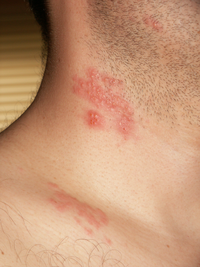
Photo from wikipedia
BACKGROUND: Charcot neuroarthropathy (CN) of the foot and ankle, which is complicated with infection, is debilitating disease and presents challenges until now. External fixation with half-pins is useful as provisional… Click to show full abstract
BACKGROUND: Charcot neuroarthropathy (CN) of the foot and ankle, which is complicated with infection, is debilitating disease and presents challenges until now. External fixation with half-pins is useful as provisional treatment. AIM: The purpose of this retrospective case series is to summarize the patient characteristic, type of surgical intervention, outcome, and complication of infected CN treated in our hospital. MATERIALS AND METHODS: This case series studied retrospectively patients with CN of the foot and ankle due to diabetes mellitus type II, complicated by infection, who required surgical treatment in a single institution, from 2018 to 2019. Diagnosis was based on chronic deformity (fracture or dislocation) as proven on X-ray and recently developed infection as shown through clinical, laboratory, and radiological evaluation. RESULTS: We studied seven patients with CN classified as Eichenholtz Stage 3 (100%) and Brodsky type 3A alone (n = 3) (Figure 1), and type 3A with other types (n = 4). The mean age is 44.6 years old (range, 35–60) and mean body mass index was 24.08 kg/m2 (range, 21.45–25.39). Signs of infection include leukocytosis (n = 6), soft-tissue swelling (n = 4), ulcer (n = 4), and osteomyelitis (n = 1) at presentation. Operative treatment consisted of debridement, followed by external fixation only (n = 4), combined external fixation and pinning (n = 2), and intramedullary pinning only (n = 1). The mean hospital length of stay was 4.5 days (range, 3–7). We performed short-term follow-up after a mean of 4.12 months (range, 1.3–5.3) and long-term after a mean of 15.02 months (range, 11.27–16.8), the limb salvage rate was 100% in both. One patient had revision of external fixation. As for functional outcome, at the time of long-term follow-up mean visual analogue scale was 0.75 (range, 0–2) and American Orthopaedic Foot and Ankle Score was 66.25 (range, 57–77). CONCLUSION: In this study, mostly external fixation with half-pins and methyl metacrylate was used based on the bone condition and patient’s compliance. Despite of its limitation, this method is effective when it is combined with strict blood glucose level and infection control.
Journal Title: Open Access Macedonian Journal of Medical Sciences
Year Published: 2021
Link to full text (if available)
Share on Social Media: Sign Up to like & get
recommendations!